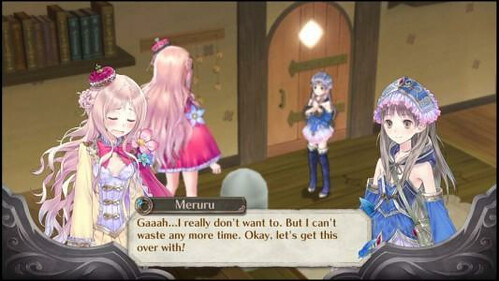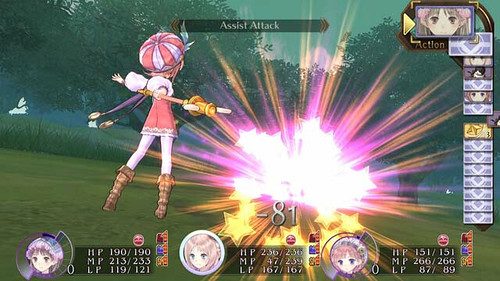|
Disclosure: We may earn a commission from links on this page
|
Developer: Gust | Publisher: Nippon Ichi Software |
| Release Date: May 29, 2012 | Available On: PS3 |

When I first put Atelier Meruru: The Apprentice of Arland into my PS3, I was excited – after seeing the Atelier games sitting on store shelves on numerous occasions, I have always been interested in trying one of them. I would always continue to browse, but I always went back one last time to check out one of the previous Atelier entries – Totori or Rorona – often finding one of the spots occupied by the games totally empty.
I became more and more intrigued about the franchise, and finally got my chance with the third and final game in the series – Atelier Meruru: The Apprentice of Arland. Dedicated fans may cry foul due to my jumping into the franchise on the last installment – trust me, I try to avoid this with everything from video games to TV series – but after playing Meruru, I doubt that I would really want to revisit the predecessors anyway.
The new installment in the Atelier series follows Meruru, the young princess of Arls. Meruru’s father wants her to do something with her life, preferably serving her kingdom, but all she wants to do is alchemy – ultimately become an alchemist. Begrudgingly her father eventually agrees, but only due to his own agenda – merging his kingdom with another. This is only possible if the population of Arls increases, and the best method for such a task, naturally, is alchemy.

The game implements a timer that ticks away as you work to build up the kingdom and its population. Meruru’s journey to become an alchemist has her running around the area, performing all kinds of random tasks. She can earn points, which are spent on structures such as libraries, schools, and anything else that helps bring more people to the land. This timer ends up being one of the game’s biggest downfalls; there are various “milestones” to reach, and if you fail to increase the population and satisfy the given milestones, you are thrust into one of the ten different endings featured in the game. This can be a real problem considering that almost anything in the game takes up your precious time – practicing alchemy, battles, and travelling are all major time-crunches that make it hard to carry out your objectives.
Moving on, The Apprentice of Arland is the most nauseatingly “cute” game I have played in a while: the voice acting and dialogue are responsible for this, and ultimately work against the game. Almost all of the characters speak in high-pitched voices, and the dialogue is…well, childish, to be generous. At one point, Meruru calls her father a “poopyhead” – I cringed, and from that point forward, I knew I was in for a rough time. Before long I was forced to mute the television; I simply can’t stand to listen to terrible dialogue, and would rather read the text.
Unfortunately, this is also a problem: there were many times throughout the game where I would complete a batch of quests, only to sit through a five-minute conversation between characters discussing their feelings for each other, or some other asinine rambling that has little or nothing to do with the specific destination I’m trying to reach or the items I’m trying to gather for the quest I’m trying to complete.

Despite going far out of its own way to be “cute”, there are some aspects of Atelier Meruru that definitely stood out to me. For example, I really wish more games looked like this – the art style is similar to the Tales franchise, with vivid and colorful visuals that include detailed environments and character designs. The cel-shaded style is joined by some very well-drawn static images of the characters, which pop up during the conversations. The framerate actually lags a bit when entering larger areas, but these instances were really the only graphical hiccups I witnessed.
Also, more RPGs need to feature this level of balance between the in-game activities and the combat. In fact, my favorite parts of Atelier Meruru were based on the alchemy portion of the game. I literally spent hours upon hours tinkering with alchemy recipes, crafting various items – many of them just because I could, not necessarily because I needed them. Performing alchemy is actually required to complete certain quests in the game as well as assisting players in combat. For example, there were some encounters in the game that seemed impossible to win under normal battle conditions. Instead of fighting in vain and wasting precious days on my timer, I visited the workshop and crafted items that helped turn the tide in my favor. From bombs to healing salves, there are plenty of items that can be put together, and sometimes alchemy seems to be the only real way to win the fight.

As I said, there’s definitely a balance: some characters are based around their fighting skills, others around the use of items, and lastly some that focus on casting magic spells. Each battle must be strategically planned, with factors such as character weaknesses and individual abilities coming into play.
Again, the game shines brightest with its alchemy mechanic, and I ended up wasting most of my time between each milestone making random items. Sure, plenty of games feature item-crafting features, but more of them should boast the complete alchemy system seen in Atelier. The process of sifting through a bulky inventory to locate random components would be more appealing if there was always this kind of reward system; Meruru’s alchemy level rises as you make new items, ultimately yielding new recipes – some more useful than others. Some of these recipes require her to build a “core component”, which must be crafted from an entirely different set of objects. This may sound like a pain, but Meruru actually earns more experience points for the inital crafting of the core component before building any more of the required items.
Shortly after I began playing Atelier Meruru, I found that I wasn’t enjoying the game much at all – as I progressed further, I started to enjoy certain aspects of the game, but my interest was waning. Unfortunately, despite my attempts to get past the dialogue and voice acting – easily the two biggest drawbacks of the game – I couldn’t get past it, and my enjoyment of The Apprentice of Arland was ultimately ruined by the unbearably cheesy, campy voices that are constantly chattering back and forth. I can enjoy cheesy dialogue from time to time in video games…just not like this.
Don’t get me wrong, Atelier Meruru has some things going for it: the battles are entertaining, alchemy is addicting, the visual style is very attractive. I really wanted to like this game, but I never reached that level of enjoyment that I typically find in JRPGs, and I think this one is best saved for the very small niche crowd that it seems to be designed for.
| Graphics: | 8.5 |
| Sound: | 3 |
| Gameplay: | 8 |
| Creativity: | 8.5 |
| Replay Value/Game Length: | 7 |
| Final: | 6.8 out of 10 |
| Written by Drew Meadows | Write a User Review |
